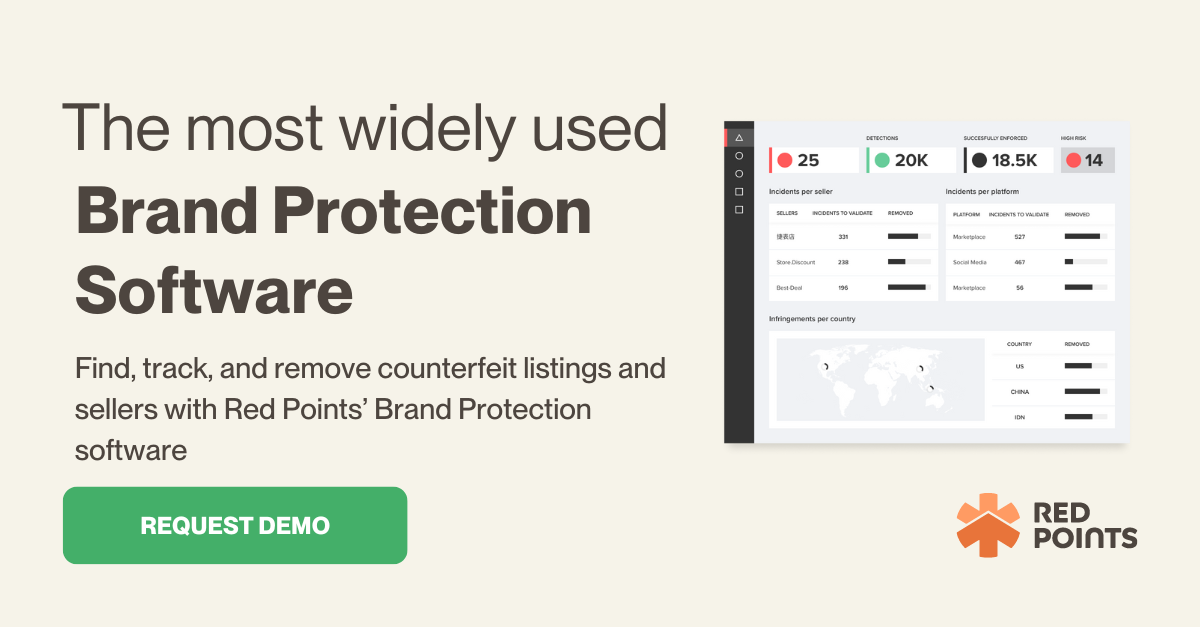
Table of Contents:
Last updated on: February 13, 2024
The counterfeit industry has grown into a multi-trillion-dollar industry.
As a business, it’s your responsibility to take full ownership and accountability for your brand. Bad actors are staying ahead of the curve with cutting-edge Artificial Intelligence used to outsmart traditional counterfeit detection methods.
This article dives into the intricate world of AI’s role in this modern battle against counterfeiting, revealing a complex cat-and-mouse scenario between counterfeiters and those guarding their brand integrity. We unravel how AI is not just a tool currently used by counterfeiters to act faster but also a powerful tool in the hands of those responsible for protecting authentic products and brands.

Counterfeiting has been around for almost as long as currency itself. It was around 400 BC when historians recorded the first instance of counterfeit coins covered by a less valuable metal with a layer of precious metal. The widespread practice of counterfeiting coins led to the rise of official coin testers, employed specifically as a security measure to weigh and cut coins to check the metal at the core.
Today’s instances of counterfeiting have become much more complex. AI algorithms have become extremely well-versed in deep learning for product replication or even natural language processing to create convincing product listings. Prescriptive analytics with machine learning has aided manufacturers in identifying lucrative opportunities while providing recommendations to evade detection from antiquated detection systems.
The impact that has left on international trade is tangible and growing. In 2019, counterfeit products accounted for as much as $464 billion, or roughly 2.5% of world trade. This would make the counterfeiting economy larger than even Canada’s total GDP.
By 2023, that number would exponentially increase to $2 trillion worth of counterfeit products yearly. The increasing prevalence of counterfeit products has become a cause of concern for both economic and security reasons.
Salvatore Ingrassia, Port Director for JFK Airport, highlights it best in an interview with CBSNews, “We have hundreds of reports of houses being burnt down based on these types of counterfeit electronics.”
The implications extend beyond financial harm; counterfeit products, especially in sectors like pharmaceuticals and automotive sectors, can pose significant risks to the health and safety of the end user.
AI’s role in combating counterfeiting is not a one-stop solution with both attackers and security experts looking to leverage AI detection and evasion methods in a cat-and-mouse game that requires everyone to stay on their toes.
AI-powered brand protection services can leverage different techniques to find products, services, and full-scale operations imitating your organization. With tech-oriented brand protection providers, you can optimize your workflow, tackle the largest threats first, and keep track of your impact across platforms.
Artificial intelligence (AI) refers to machines’ ability to perform tasks that were typically associated with human intelligence, such as learning and problem-solving. At Red Points, we use AI to scale our Brand Protection efforts.
One of the types of AI that we use is called Machine Learning (ML).
In simple terms, we use Machine Learning to train our platform to correctly identify the asset that a brand wants to protect by manually validating the detection. Once this training is completed, the platform will have the data to accurately identify if the asset is present in the image or link. These processes are unique to every client and are performed during onboarding.
Machine learning is applied to a diverse range of tasks that include computer vision and natural language processing. Each task has its own set of technologies that enable us to, for example, identify if a logo is included in an image and detect if a counterfeiter is using the same catalog images as the legitimate brand, even if they have removed the logo.
Machine learning-powered technologies have specific objectives to achieve. The following are some of the primary outcomes that we can obtain by utilizing these AI methods: :
As the world grapples with constantly evolving counterfeit products, AI remains a key player in the fight against this illicit activity. Looking forward, further AI integration is key to staying ahead of the curve, likely influenced heavily by the following points:
Improved legislation
Despite the strong bipartisan push for AI regulation, comprehensive bipartisan bills and frameworks are still in the works by the U.S. government. The Blumenthal-Hawley framework, for example, highlights the need for an independent oversight body that allows companies to develop “sophisticated general purpose AI models” while continuing to promote consumer data by providing them control over the personal data they provide.
Classifying AI-generated evidence as admissible in court would also be a regulatory change that pushes the envelope in the combat against the $2 trillion counterfeit industry.
Employing vigilant guardians
They say, “Crime doesn’t sleep.” Security companies today are already implementing perpetual AI security systems capable of continuously monitoring multiple platforms for counterfeit products.
For example, Red Points’ Brand Protection Software enforces your trademarks 24/7. Should there be any validated infringements found on any online platform/marketplace, Red Points takes immediate action and requests a takedown automatically.
Human expertise
The effectiveness of AI in fighting counterfeit products will continue to depend on human expertise. This includes AI training and dashboard interpretation. Regarding prescriptive analytics and recommendations, final decisions on ambiguous cases where AI may lack context should still be left to humans with more nuance.
There will also be an increased emphasis on training professionals in fields specifically related to AI and counterfeit products. This ensures expertise in managing and interpreting AI systems.
On that note, working with an expert team boasting a proven track record is a necessary step to successfully combating AI counterfeits.
With the widest customer base in the industry, Red Points’ Brand Protection services boast a proven team that can outmaneuver even the most sophisticated bad actors.
There’s a reason over 1,300 leading brands chose us among other brand protection companies, and that’s because we’ve taken down over a billion dollars worth of counterfeit products that stood to harm world-renowned companies like FILA, Hugo Boss, and Kaspersky. Take the first step and book a 15-minute consultation with one of our experts.
